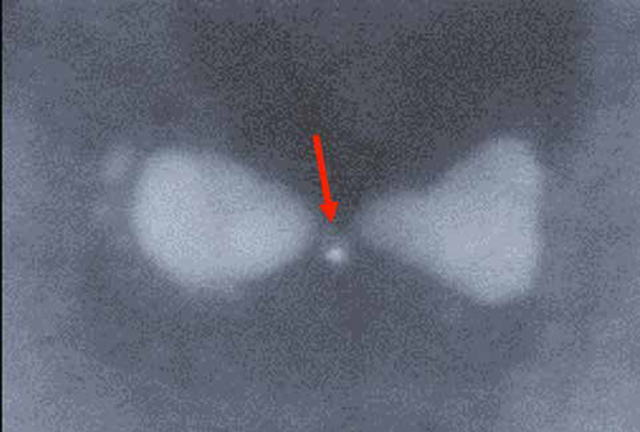Bowtie-shaped nanostructures may advance the development of quantum devices

A bowtie-shaped nanoparticle made of silver with a trapped semiconductor quantum dot (indicated by the red arrow)
Bowtie-shaped nanoparticles made of silver may help bring the dream of quantum computing and quantum information processing closer to reality. These nanostructures, created at the Weizmann Institute of Science and described recently in Nature Communications, greatly simplify the experimental conditions for studying quantum phenomena and may one day be developed into crucial components of quantum devices.
The research team led by Prof. Gilad Haran of Weizmann’s Chemical Physics Department – postdoctoral fellow Dr. Kotni Santhosh, Dr. Ora Bitton of Chemical Research Support and Prof. Lev Chuntonov of the Technion-Israel Institute of Technology – manufactured two-dimensional bowtie-shaped silver nanoparticles with a minuscule gap of about 20 nanometers (billionths of a meter) in the center. The researchers then dipped the “bowties” in a solution containing quantum dots, tiny semiconductor particles that can absorb and emit light, each measuring six to eight nanometers across. In the course of the dipping, some of the quantum dots became trapped in the bowtie gaps.
Under exposure to light, the trapped dots became “coupled” with the bowties – a scientific term referring to the formation of a mixed state, in which a photon in the bowtie is shared, so to speak, with the quantum dot. The coupling was sufficiently strong to be observed even when the gaps contained a single quantum dot, as opposed to several. The bowtie nanoparticles could thus be prompted to switch from one state to another: from a state without coupling to quantum dots, before exposure to light, to the mixed state characterized by strong coupling, following such exposure.
Therefore, the ability to control the coupling of quantum dots may one day be employed in the manufacture of switches for computing or encryption devices relying on quantum phenomena, that is, those operating at the level of photons and single quantum systems, such as atoms, molecules or quantum dots. Because such phenomena open up possibilities unavailable on the macroscopic scale – for example, performing multiple computations simultaneously – quantum devices are expected to be vastly more powerful than today’s electronic computers and encryption systems.
Says Prof. Haran: “We’ve made a first step toward creating quantum switches using our coupling method. Much research needs to be done before the method can be incorporated into actual devices, but as a matter of principle, our system is relatively easy to generate and, most importantly, can function at room temperature. We are currently working to fabricate even smaller bowtie particles and to render the coupling stronger and reversible.”
The Weizmann scientists managed to design their bowtie system thanks to advances in nanotechnology – including electron beam lithography, used to fabricate the bowties and to facilitate the introduction of quantum dots into their gaps – and the advent of computational programs providing data analysis that previously required a massive effort on the part of theoreticians. They also relied on the recently improved understanding of electron oscillations triggered by light in metals, which constitute the physical source of the coupling between the bowtie nanoparticles and the quantum dots: Such oscillations are known to be strongest on the metal surface. In the new bowtie-shaped particles, the electromagnetic field generated by these oscillations is extremely concentrated because it is focused to the central, narrow portion of the bowtie, much as light is concentrated when focused into a narrow beam.
The high concentration ensures tight control over the coupling, and this control, in turn, is essential for potential future quantum applications. None of the systems built in the past to study quantum interactions between light and matter operated on such a small scale or were able to reduce experiments to the level of individual quantum dots, as was done in the Weizmann study.
Prof. Gilad Haran's research is supported by the Ilse Katz Institute for Material Sciences and Magnetic Resonance Research, which he heads; the Nancy and Stephen Grand Research Center for Sensors and Security, which he heads; the Henry Chanoch Krenter Institute for Biomedical Imaging and Genomics; the Carolito Stiftung; the Weston Nanophysics Challenge Fund; Mr. and Mrs. Antonio Villalon; and the Prof. Dov and Ziva Rabinovich Foundation. Prof. Haran is the incumbent of the Hilda Pomeraniec Memorial Professorial Chair.
